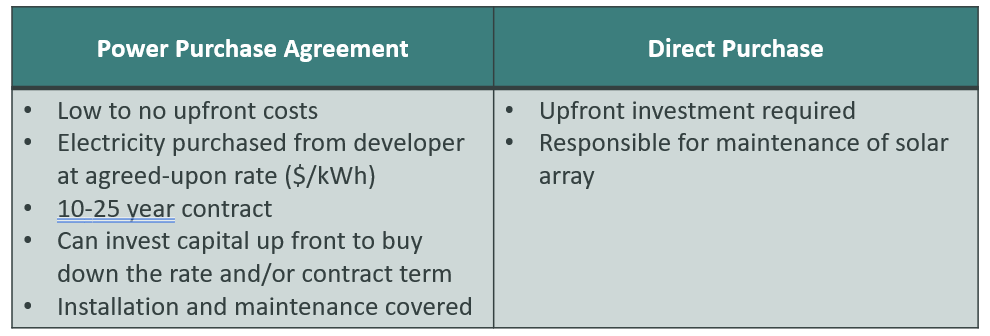Many agencies and public facilities are becoming interested in developing solar on their lands or facilities. One of the biggest decisions to make is how to procure the solar array. In this post, we consider two options: a Power Purchase Agreement (PPA) or direct purchase.
How does a PPA work?
With a PPA, an agency provides access to lands and/or facilities to a solar developer, then purchases the electricity from the developer at a contractually agreed-upon rate, typically for 10 to 25 years. PPAs are economical if the agreed-upon utility rate is less than the current utility rate. The electricity can either be supplied directly to facilities that are adjacent to the array (connected "behind the meter"), or it can be delivered from the developer to the agency through the existing power grid. Delivery through the existing power grid adds approximately 3 cents/kWh to the total utility costs (the typical rate of delivery in Illinois). Thus, electricity that is supplied directly to facilities is more economical because it can avoid the delivery cost.
To save on total contract costs, some organizations find it preferable to incorporate a contractual provision to allow for a buyout of the PPA at an earlier point in time, for example at 7 or 10 years. Other organizations decide to invest capital up front to buy down the rate and/or contract term.
One benefit of a PPA is that the developer is responsible for ensuring ongoing operation and maintenance throughout the duration of the contract. Many organizations struggle to find the budgetary resources to adequately maintain facilities, and in the case of solar systems, maintenance shortfalls can seriously degrade the system performance and reduce or eliminate the potential for cost savings and renewable energy generation.
Taking advantage of incentives
With PPAs, a private entity owns the solar system and can take advantage of Federal Investment Tax Credit for substantial cost savings. The solar developer then may pass along savings from the tax credit to the agency through reduced utility costs. The tax credit previously was 30% of the cost of the system, and is decreasing, presently 26%, falling to 22% in 2021 and 10% thereafter. In Illinois, solar developers may also be able to take advantage of Adjustable Block Program incentives or Solar for All Program incentives, depending on availability. These incentives can substantially reduce the utility rate.
Direct purchase option
Alternatively, agencies can decide to purchase the solar array directly. They would be responsible for purchasing, installing, and maintaining solar panels and managing the power they generate. This option may present challenges given budget constraints. When capital funds are available for direct purchase and installation, this type of procurement has the potential to be a more streamlined process, when compared to a PPA. It is critical to allocate the necessary staffing and/or funding resources so that any solar system receives adequate maintenance and repairs as needed and required. The table below summarizes the pros and cons of procuring a solar array through a PPA or direct purchase.






